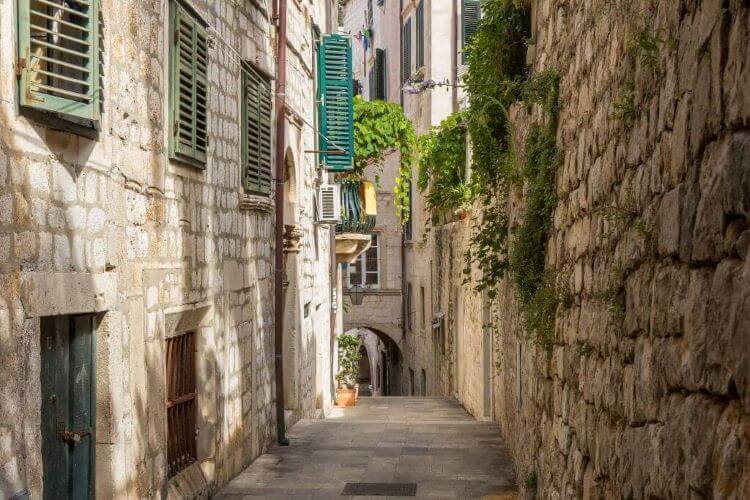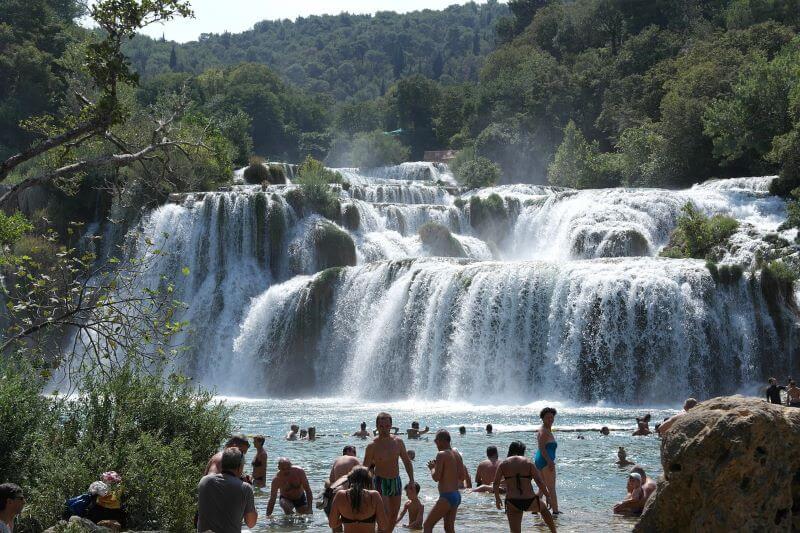Known as the “Pearl of the Adriatic” Dubrovnik is one of the world’s finest and best-preserved medieval cities. With its pristine location in Croatia on the Adriatic Sea, Dubrovnik Old Town is filled with steep cobbled lanes, Renaissance fountains, monasteries and palaces, and Baroque churches.
Of course, it’s a must-visit destination for fans of Game of Thrones because it is the filming location of King’s Landing.
Visiting Dubrovnik Old City – Things to Do
As you can see, finding things to do in Dubrovnik is no effort and it means that this is a place you should spend more than a few days in. A week in this global city is the perfect amount of time.
Dubrovnik’s Old town is surrounded by stone walls that were built between the 11th and 17th centuries. These walls gave the city-state (then called Ragusa) protection from incursions from its enemies and the City was a rival to the famous trading port of Venice.
Today you can the wall surrounding the Old Town and enjoy unparalleled vistas of the city and Dalmatian Coast with panoramic views of the Adriatic and the islands of Croatia.
In fact, it’s not just the city walls that a visitor can walk – the whole of the Old City is a pedestrian-only zone for you to discover! Read on to discover the wonderful things to do in Dubrovnik Old Town.
Walk the Old Town Walls
Dubrovnik’s old town center is a UNESCO World Heritage site. After the civil war of the early 1990s the City was restored to its former glory and today all new building work and restoration are controlled down to the shade of green used on the shutters along the main street.
Old Town is a traffic-free zone which means no cycling or driving which makes sense as the steep streets and stairs throughout old Town make driving or riding a bike virtually impossible.

The Old Town walls walk is around 2 kilometers (just over a mile) and these magnificent 13th-century walls will provide you with absolutely stunning views of the terracotta rooftops of the City.
The walls include the St. John Fortress, 5 bastions, 2 corner fortifications, and 17 towers. The cost of a ticket is 200 HRK (about 29 Euro) children and students concession – 50 HRK.
Rector’s Palace

Within the Rector’s Palace is the Cultural History Museum. The Palace dates back to the 15th century and is where the Rector or Governor would live during his term in office. The Museum is full of period furniture, portraits of nobles, costumes, and other cultural items from Dubrovnik’s past.
You may recognize the Palace from the Game of Thrones series where it was the location for the Spice King of Qarth’s atrium.
You’ll find much of the commentary throughout the country in Croatian, so you can also make your upcoming adventure even better by taking some time to learn Croatian language basics which will make getting around and meeting people much easier.
Dubrovnik Cathedral

You will find the 17th-century Baroque Cathedral near Rector’s Palace.
Its treasury includes ornately crafted gold reliquaries of saints including St. Blaise’s skull, he is the patron saint of Dubrovnik.
Franciscan Monastery

A beautiful 14th-century cloister sits within the monastery along with the oldest pharmacy in Europe which has been operating since 1317. The museum inside has a collection of chalices, paintings, and gold jewelry alongside relics and liturgical pieces.
At the center of the monastery sits a small beautiful garden shaded by palm and orange trees.
Dominican Monastery

The Dominican Monastery of Dubrovnik has a cloister featuring some of the most impressive stonework in the City and is considered an important historical and architectural piece of Dubrovnik’s rich past.
The stairs leading to the entrance are an iconic image of this amazing Old City.
The Monastery also displays important artworks from ancient Dubrovnik.
Red History Museum
A wonderful find in Dubrovnik, this Museum is a must-visit to understand the culture and the effect of communism on the people of Croatia. It’s also run by some very cool people and it’s a fun and informal space.
This newer Croatian Museum’s aim is ” to encourage dialogue, further exploration and learning about the history of socialism so that we can bridge the division of the past and responsibly move forward”.

The ‘rooms’ in the museum take you to the era, complete with food, decor, and clothing. The explanations of how the secret police operated are chilling because it is juxtaposed with this seeming normality of everyday life.
The Red Museum is quickly becoming a global museum sensation.
For a comprehensive guide to all of Dubrovnik’s unique museums, read Best Dubrovnik Museums.
St Blaise’s Church
Saint Blaise’s Church is an elaborate and flamboyant example of the Venetian Baroque style of building. It is dedicated to the patron Saint of Dubrovnik St. Blaise who is credited with saving the citizens of Dubrovnik from the Venetian army in the 10th century.
In a devastating fire during the earthquake of 1706, the only remaining treasure of the Church was a silver statue of St. Blaise.

Today this statue is considered not only miraculous but is one of the most important in Dubrovnik and the model held in the hands of the statue reveals a miniature of the city at that time.
Fort Lovrijenac

Lying just outside the Old Town this 13th-century, Lovrijenac fortress is well worth a visit although you do have to climb up 175 steps to the upper levels. However, once there you will be afforded some stupendous views of the City Walls.
Pile Gate
A statue of Sveti Vlaho (which translates as St. Blaise, the patron saint of Dubrovnik), is set above the gate which is now approached by a stone bridge that crosses what was the moat of Dubrovnik.

The entrance to Dubrovnik is through the front gate – the Pile Gate one of the four original gates into the walled city. Built in the 15th century in Romanesque style, it once had a wooden drawbridge to keep out unwanted guests arriving from the port.
Ploce Gate (Vrata od Ploca)

The eastern entrance to the city is through the Ploce Gate with a bridge similar to that at the Pile Gate entrance. This gate was constructed in the 14th century and there is a statue above the gate of St. Blaise, the patron saint of Dubrovnik.
Sponza Palace
“Spongia” is from the Latin word for a place where water gathers or is collected. This sixteenth century it became a cultural center for the Republic of Ragusa but its atrium was a center of trading, commerce, and business dealings.
I love the inscription above an arch in the atrium that reads, “Our weights do not permit cheating. When I measure goods, God measures with me.”

The counting that occurs now is of a more literary kind – Sponza Palace houses archives that were originally kept in the Rector’s Palace. Some of these works date back to the 1100s.
Stradun
The Stradun is the main street in Old Town. It is so atmospheric, it was used for filming Star Wars Episode IX! From the Stradun, you will be able to find the main visitor attractions listed below.

Running for 300 meters, the Stradun is paved with limestone and is more commonly called the Placa. It runs east-west and connects the Pile Gate to the Ploce Gate.
Fountains and bell towers mark each end of the street. Many of Dubrovnik’s most important buildings are on the Stradun, and it is the site of the St. Blaise festival, and its where New Year’s Eve is celebrated.
Gundulić Square
If you start out early in the morning try to visit the open-air market that takes place every morning in the square.

You can wander the stalls selling local produce from cherries and strawberries to fresh figs and peaches during the spring and summer months. In late autumn you will find walnuts, pomegranates, and lemons on display.
The market also makes a wonderful place to grab a snack and some refreshments while people watch.
Cable Car ride

If you are not afraid of heights then you must take the Dubrovnik cable car ride up to Mount Srd.
The trip up is less than 2 minutes and there’s a cafe where you can have a bite to eat whilst drinking in the fabulous views of the city and out over the bay.
Free Walking Tours of Dubrovnik
While you are visiting Dubrovnik, take advantage of some free walking tours of the City. Tours are available for the Game of Thrones filming sites and a historical walking tour that takes in many of Dubrovnik’s most interesting sites.
If you decide that you want some outdoor activities then take advantage of the glorious Dalmatian coast with its rock and pebble beaches for swimming and water sports, take a taxi boat to the Elaphiti Islands, or challenge yourself to a sea kayaking tour.

A must-do is to take the boat over to visit Lokrum, a protected natural reserve with beautiful botanical gardens.
Dubrovnik is an outstanding city to visit, with so much to see and do it should be on your bucket list for Europe. Check out the best tours below if your time here is short.
Best Game of Throne Tours
Frequently Asked Questions
- What country is Dubrovnik in?
- Dubrovnik is the capital of Croatia.
- Where is Dubrovnik located?
- Dubrovnik is located on the Adriatic Sea in Southern Croatia.
- Where is the old town of Dubrovnik?
- Old town Dubrovnik lies within the city’s ancient walls that face the port and the sea.
- What is the Dubrovnik castle?
- Fort Lovrijenac (see above) is sometimes called Dubrovnik Castle.
- Why is Dubrovnik a walled city?
- Dubrovnik city faced invaders from the sea over six centuries. That’s a long time to be constantly on guard against invasion and raiding! The walls of Dubrovnik were constructed between the 11th and 17th centuries.
- What is the Dubrovnik population?
- The population of Dubrovnik is 42-43,000.
- What is the Dubrovnik weather like?
- Dubrovnik has pretty wonderful weather – the temperature ranges from about 4 degrees Celsius in winter to about 29 degrees Celsius in summer. Mid-May to mid-September provide perfect weather for swimming and enjoying the Dalmatian Coast. The only downside of visiting Croatia in winter is the rainfall – it can have very wet winters.
- When is the best time to visit Dubrovnik?
- Ideally, a visit in September or October avoids the busiest summer months for cruise ships but still takes advantage of the late summer weather. June is still not as crowded as July and August and although May is pleasant, the weather in April can be variable.
In terms of peak season months, July and August will allow you to experience the wonderful Dubrovnik Summer Festival.
Further Resources
- What are the absolutely unmissable places to see and things to do when you travel to Croatia? See my ultimate guide to Croatia here (including Lokrum island) and take a peek at some of the world’s most unique museums in my article on Best Dubrovnik Museums.
- If you’re planning a day trip by boat or ferry to beautiful Hvar Island, you simply must visit the Croatian hidden gem of Stari Grad.
- Are you planning a trip to Italy? Perhaps to the Cinque Terre? See my detailed travel guides to the Cinque Terre here
- If you’re on a lovers’ trip to Europe, consider that other iconic destination, Santorini. Read my Athens and Santorini posts here





